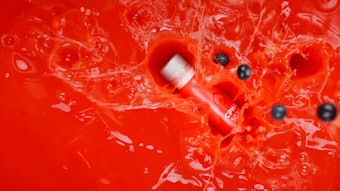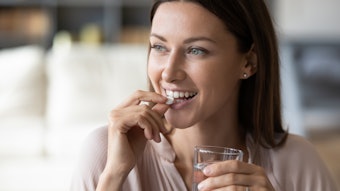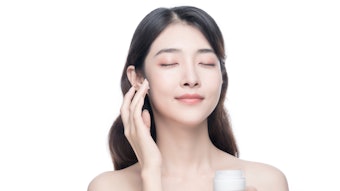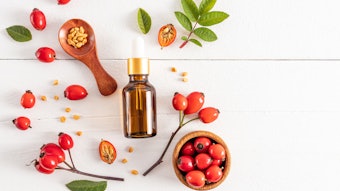
Skin breakdown is implicated in many areas of human health, including dermatology, tissue viability and personal care. And as is generally known, the skin acts as a barrier between internal and external environments, protecting the body from mechanical damage, external substances, pathogens and irradiation. The skin also regulates body homeostasis by reducing transepidermal water loss (TEWL). However, when physiological changes occur, such as those associated with intrinsic aging and the accumulation of exogenous damage, skin’s functioning is altered, in turn affecting skin health and appearance.1-3
TEWL is a direct reflection of the integrity of the epidermal barrier in the stratum corneum (SC). Specifically, it is a measure of the flux density of condensed water diffusing to the skin surface [g/m2/hr]. Evidence has shown that lower levels of TEWL indicate an improvement in skin barrier function.27 Normal TEWL values in one healthy adult population (n = 167) have recently been suggested.1 For the mid-volar right and left forearms, levels of 6.5 g/m2/ hr (i.e., 6.2–6.8) and 8.7 g/m2/hr (6.5–10.80), respectively, were reported.
In relation, the effects of diet on health and well-being are gaining interest by both the general public and researchers. Many individuals consume poor diets with insufficient quantities of nutrients, increasing their risk for dietary-related diseases.4 Although the impact of nutritional status on skin condition is still unclear,5-7nutritional science has advanced its understanding of the relationships between food and skin health.8 For example, polyunsaturated fatty acids (PUFAs), including omega n-3 and omega n-6, are one type of micronutrient associated with improved skin health.8, 9
Additional benefits have been found in derivatives of PUFAs such as linoleic acid (LA) (n-6) and α-linolenic acid (n-3). Notably, these essential fatty acids (EFAs) cannot be synthesized by humans. Derivatives of linoleic acid significant for human health include arachidonic acid and γ–linolenic acid (GLA).10 GLA, e.g., can be found in evening primrose oil and borage oil. It reduces inflammation by reducing the synthesis of inflammatory mediators and by increasing the production of eicosanoids.11
The present article reviews what evidence there is to support the use of PUFA oral supplements to improve skin health and barrier functioning.
The Search
Searches of the Medline, Embase and CINAHL databases were conducted through July 2014 using the following terms: supplement or nutrition or diet or food and TEWL; and NOT mice or rat. No restrictions were placed upon language, year of publication or source. In total, 78 abstracts with 9 clinical studies were included in the final analysis (see Table 1); non-human studies or those without dietary interventions were excluded.
Linoleic Acid Findings
γ–Linolenic acid is an essential fatty acid for the skin, produced from LA by the body at a low and potentially insufficient rate.13 Studies involving the supplementation of GLA-rich oils demonstrated an impact on TEWL in people with dry skin13 and the elderly,12 as well as healthy volunteers.14 Supplementing with 360 mg or 720 mg of GLA/day reduced TEWL levels in the elderly; 345 mg/day reduced levels in younger individuals with dry skin. A significant 10.8% reduction (p < 0.05) in TEWL was reported after eight weeks of use compared with baseline; a 7.7% reduction was observed after 12 weeks, relative to the control.12, 13
Puch et al.14 demonstrated an earlier effect on TEWL by administering a supplement containing catechins, probiotics, vitamin E and GLA-rich borage oil (300 mg/day) in a dairy matrix. A statistically significant reduction in TEWL was reported at six weeks relative to the placebo; 13.25% (p = 0.026) in the total study population and 15% (p = 0.005) in the sub-group of participants with BMIs < 25.14
In other work, cream sandwich wafers with GLA (200 mg/day) had no statistically significant effect on TEWL in the total study population, only on the sub-group with high levels of pro-inflammatory metabolites in their plasma.17
Flaxseed oil is rich in α-linolenic acid, the precursor of GLA, and this oil was shown to reduce TEWL by 25.8% (2.2 g/day, p < 0.05) over a 12-week period in women with sensitive and dry skin.16 A reduction of 31.4% (p < 0.05) was observed after administration over 12 weeks (2.2 g/day) in women having sensitive skin and a BMI ranging from 18 to 25 kg/m2.5 Taken together, the data suggests there is evidence that GLA improves skin barrier function.5, 12-17
α-Linolenic Acid Findings
α–Linolenic acid and its derivatives eicosapentaenoic acid (EPA) and docosahexaenoic acid (DHA) have anti-inflammatory effects in skin conditions.19 Fish oils containing EPA and DHA have been associated with improved leukocyte functionality and decreased inflammation, characterized by altered cytokine release and decreased lymphocyte proliferation.11
Segger et al.20 showed that supplementation with fish oil containing EPA and DHA and enriched with GLA resulted in a trend toward reduced TEWL. However, this was not statistically significant.15 Neither was safflower seed oil, perhaps due to the low baseline TEWL values reported.5 Nor did a mixture of n-3 essential fatty acids have any effect on the skin barrier function.4
TEWL is a relative parameter—not absolute—and intra-individual changes are easier to interpret than between-group comparisons.
More recent studies have failed to identify TEWL reduction, which highlights the high inter-individual variability of TEWL measurements in heterogenic populations having differences in genetics, BMI and pro-inflammatory plasma statuses.4, 7, 14 Seasonal changes can play a role as well, since studies vary in duration, e.g., from four to nine months in length.4, 7
Furthermore, in a 14-week study, administration of n-3, isoflavones, lycopene and vitamins C and E led to an increase in TEWL.18 Taken together, there currently appears to be no evidence for beneficial effects of linolenic acid supplementation on TEWL.
Supplementation in Diseased Skin
Increased TEWL values have been observed in conditions linked to barrier disruption including EFA deficiency,21 atopic dermatitis22 and psoriasis.23, 24 However, although GLA appears to benefit healthy skin, the evidence in diseased skin is conflicting.
A recent review from Cochrane concluded that oral borage oil and evening primrose oil lack effects on atopic eczema, as compared with placebo-treated volunteers.25 In contrast, administration of GLA with n-3 fatty acids was reported to benefit psoriasis.26
Potential PUFA Mechanisms of Action
The mechanisms by which PUFA-based supplements maintain skin integrity are not yet understood. Epidermal lipids play an essential role in maintaining skin barrier function due to their unique composition of 50% ceramides, 25% cholesterol and 15% free fatty acids in the lipid lamellae.27 Changes in this lipid organization have been reported in cases of psoriasis and atopic dermatitis.28
In relation, LA is a precursor of ceramides, the most abundant fatty acid in the barrier-forming extracellular lipid matrix.19, 29 In addition, PUFAs are necessary for barrier functioning and must be obtained through the diet. Their deficiency leads to substitution by oleic acid and abnormal skin barrier functioning.30
DHA and EPA, however, are not major constituents of the epidermis. They appear to play an immuno-modulating role, possibly by altering phospholipid epidermal profiles.19
Discussion: Limits of this Review
Readers must note, this review is limited due to the inadequate quality of reporting in the papers that were screened. Some studies lacked baseline values or statistical analysis, or unclearly reported sample characteristics. Ideally, the presentation of TEWL measurements should include mean and standard deviation measurements, baseline values, details about measurement conditions, adequate sample sizes (determined by power calculations) and characteristics including ethnicity, gender and age; season; and measurement area, device and procedure.
TEWL measurement variations: TEWL is influenced by many factors, including the site of measurement, measurement conditions, device, methodology, climate, health and age of the study population. Therefore, TEWL is a relative parameter—not absolute—and intra-individual changes are easier to interpret than between-group comparisons.1
Although several TEWL devices are available, the studies were carried out under standardized environmental conditions, as suggested in measurement guidelines, and the measurements correlated well between devices.31, 32 However, statistically significant differences were not found in the majority of TEWL studies. Dayan et al. suggested this lack of statistical significance may be due to large inter- and intra-subject variability.4
The standard deviations observed for measurements were at least half of the mean values. While measurement conditions were standardized, other environmental factors and seasonal changes could have contributed to the observed variability.4 Nuutinen et al. showed a coefficient of variation of 8% following 10 repeated TEWL measurements on the volar forearm, and noted reproducibility values of 3% to 8% for the TEWL measurement equipment.33 Furthermore, TEWL is generally lower in the elderly, compared with middle-aged adults.1
Season also is known to affect skin metabolism as skin barrier function deteriorates and TEWL increases over the winter period.34, 35 It is clear that there are substantial limitations associated with TEWL measurements.
Some evidence suggests oral GLA supplements can improve barrier function.
Measurement sites: All reviewed studies were conducted on the forearm; however, the exact positions were not specified, contributing to greater variation. The right volar forearm is the most frequently used area in dermatological research.1 A statistically significant TEWL increase from proximal to distal area is typical. Also, the volar forearm shows larger TEWL differences between younger and older individuals, compared with the dorsal forearm, which is typically exposed to UV radiation.1
Body mass index: The prevalence of obesity has increased over the past 30 years, leading to an increase in skin diseases.36 Body mass index (BMI), as defined by the ratio of body weight to the square of body height (kg/m2), provides a standardized indicator of obesity in clinical studies.37 Loffler et al. studied the relationship between BMI and the physiological function of the skin, showing a significant correlation between higher BMI and higher TEWL, and suggesting a fundamentally changed epidermal barrier.38
Puch et al.14 found that normal weight participants (BMI < 25) responded better to supplementation than overweight participants (BMI >25), based upon TEWL measurements. The skin barrier was weaker and redder in the obese, suggesting the supplement may not work as well in overweight individuals.14
In contrast, Guida et al. observed reduced TEWL rates in obese subjects, compared with normal weight subjects (BMI 18.5–24.0 kg/m2), suggesting that obesity reduces the water permeability of the skin barrier.36
TEWL to measure skin barrier function: Evidence suggests that oral GLA supplements can improve barrier function. A 6% to 31% reduction of TEWL was reported, which is in line with clinical improvements observed in the elderly; dry and sensitive skin; skin texture; itching; and perceived appearance.5, 7, 13, 16, 18 Studies that observed no changes in TEWL reported other benefits induced by supplementation, e.g., clinical improvement of dry skin texture and increased collagen deposition.4, 22 This suggests that although TEWL can be used as a non-invasive measure of barrier function, skin barrier challenge tests, such as stratum corneum stripping, produce a more meaningful assessment of skin barrier function than do baseline and post-treatment TEWL measurements.
The reporting of the baseline nutritional status, BMI and pro-inflammatory plasma markers can provide context for TEWL measurements, as these indices influence skin barrier function.14, 17
Conclusions
In order to be effective, nutritional supplementation should reinforce the skin barrier function to withstand structural and functional changes imposed by aging and environmental damage. Some evidence suggests oral GLA supplements can improve barrier function. Future studies reporting detailed population characteristics and measurement conditions are required to further understand this area.
It is important to include a range of barrier function measurements, in addition to TEWL, when investigating the effects of supplementation to fully assess any potential benefits.
Disclosure: As this manuscript was finalized, all authors were employed by Hull York Medical School, Hull, U.K.
References
- J Kottner, A Lichterfeld, U Blume-Peytavi, Transepidermal water loss in young and aged healthy humans: A systematic review and meta-analysis, Arch Dermatol Res 305(4) 315-323 (2013)
- A Alikhan, K-P Wilhelm, FS Alikhan and HI Maibach, Transepidermal water loss and aging, in MA Farage, KW Miller and HI Maibach, eds, Textbook of Aging Skin, Springer, Berlin (2010) pp 695–703
- E Kohl, J Steinbauer, M Landthaler and RM Szeimies, Skin ageing, JEADV 25(8) 873-84 (2011)
- Dayan SH, Arkins JP, Sharma V, Paterson E, Barnes D. A phase 2, double-blind, randomized, placebo-controlled trial of a novel nutritional supplement product to promote healthy skin. J Drugs Dermatol 2011;10:1106-1114.
- Neukam K, De Spirt S, Stahl W, Bejot M, Maurette JM, et al. Supplementation of flaxseed oil diminishes skin sensitivity and improves skin barrier function and condition. Skin Pharmacol Physiol 2011;24:67-74.
- Boelsma E, Hendriks HF, Roza L. Nutritional skin care: health effects of micronutrients and fatty acids. Am J Clin Nutr 2001; 73(5):853-64,
- Liakou AI, Theodorakis MJ, Melnik BC, et al. Nutritional clinical studies in dermatology. J Drugs Dermatol 2013;12(10):1104-9.
- Schols JMGA, Heyman H, Meijer EP. Nutritional support in the treatment and prevention of pressure ulcers: An overview of studies with an arginine enriched Oral Nutritional Supplement. J Tissue Viability 2009;18:72-79.
- Ziboh VA. The significance of polyunsaturated fatty acids in cutaneous biology. Lipids 1996;31 Suppl:S249-53.
- Thomas B, Bishop J (Eds). Manual of Dietetic Practice, 4th Edition, Wiley-Blackwell, p. 165.
- Calder PC, Zurier RB. Polyunsaturated fatty acids and rheumatoid arthritis. Current opinion in clinical nutrition and metabolic care 2001;4(2):115-21.
- Broche T, Platt D. Effect of borage oil consumption on fatty acid metabolism, transepidermal water loss and skin parameters in elderly people. Arch Gerontol Geriatrics 2000;30:139-150.
- Muggli R. Systemic evening primrose oil improves the biophysical skin parameters of healthy adults. Int J Cosm Sci 2005;27:243-249.
- Puch F, Samson-Villeger S, Guyonnet D, Blachon JL, Rawlings AV, et al. Consumption of functional fermented milk containing borage oil, green tea and vitamin E enhances skin barrier function. Exp Dermatol 2008;17:668-674.
- Segger D, Matthies A, Saldeen T. Supplementation with Eskimo Skin Care improves skin elasticity in women. A pilot study. J Dermatol Treatment 2008;19:279-283.
- De Spirt S, Stahl W, Tronnier H, Sies H, et al. Intervention with flaxseed and borage oil supplements modulates skin condition in women. Br J Nutr 2009;101:440-445.
- Kawamura A, Ooyama K, Kojima K, Kachi H, et al. Dietary Supplementation of Gamma-Linolenic Acid Improves Skin Parameters in Subjects with Dry Skin and Mild Atopic Dermatitis. J Oleo Sci 2011;60(12):597-607.
- Jenkins G, Wainwright LJ, Holland R, et al. Wrinkle reduction in post-menopausal women consuming a novel oral supplement: a double-blind placebo-controlled randomized study. Int J Cosm Sci 2014;36:22-31.
- McCusker MM. Healing fats of the skin: the structural and immunologic roles of the -6 and -3 fatty acids. Clinics in Dermatology 2010;28(4): 440-451.
- Proksch E, Brandner JM, Jensen JM. The skin: an indispensable barrier. Exp Dermatol 2008;17(12):1063-1072.
- Ziboh VA, Miller CC, Cho Y. Metabolism of polyunsaturated fatty acides by skin epidermal enzymes: generation of antiinflammatory and antiproliferative metabolites. Am J Clin Nutr 2000;71(1 Suppl):361S-6S.
- Seidenari S, Giusti G. Objective assessment of the skin of children affected by atopic dermatitis: a study of pH, capacitance and TEWL in eczematous and clinically uninvolved skin. Acta Derm Venereol 1995;75(6):429-433.
- Takahashi H, Tsuji H, Minami-Hori M, Miyauchi Y, Iizuka H. Defective barrier function accompanied by structural changes of psoriatic stratum corneum. J Dermatol 2014;41(2):144-148.
- Ghadially R, Reed JT, Elias PM. Stratum corneum structure and function correlates with phenotype in psoriasis. J Invest Dermatol 1996;107(4):558-564.
- Bamford JT, Ray S, Musekiwa A, van Gool C, et al. Oral evening primrose oil and borage oil for eczema. Cochrane Database SystRev 2013;30(4):CD004416.
- Kragballe K. Dietary supplementation with a combination of n-3 and n-6 fatty acids (super gamma-oil marine) improves psoriasis. Acta Derm Venereol 1989;69(3):265-268.
- Imhof RE, De Jesus ME, Xiao P, et al. Closed-chamber transepidermal water loss measurement: microclimate, calibration and performance. Int J Cosmet Sci 2009;31(2):97-118.
- Menon GK, Kligman AM. Barrier functions of human skin: a holistic view. Skin Pharmacol Physiol 2009;22(4):178-189.
- Rabionet M, Gorgas K, Sandhoff R. Ceramide synthesis in the epidermis. Biochim Biophys Acta 2014; 1841(3):422-34.
- Tanojo H, Boelsma E, Junginger HE, et al. In vivo human skin barrier modulation by topical application of fatty acids. Skin Pharmacol Appl Skin Physiol 1998; 11(2):87-97.
- Rogiers V. EEMCO guidance for the assessment of transepidermal water loss in cosmetic sciences. Skin Pharmacol Appl Skin Physiol 2001;14(2):117-128.
- Pinnagoda J, Tupker RA, Agner T, Serup J. Guidelines for transepidermal water loss (TEWL) measurement. A report from the Standardization Group of the European Society of Contact Dermatitis. Contact Dermat 1990;22(3):164-178.
- Nuutinen J, Harvima I, Lahtinen MR, Lahtinen T. Water loss through the lip, nail, eyelid skin, scalp skin and axillary skin measured with a closed-chamber evaporation principle. Br J Dermatol 2003;148(4):839-841.
- Conti A, Rogers J, Verdejo P, Harding CR, Rawlings AV. Seasonal influences on stratum corneum ceramide 1 fatty acids and the influence of topical essential fatty acids. Int J Cosmet Sci 1996;18(1):1-12.
- De Paepe K, Houben E, Adam R, Hachem JP, et al. Seasonal effects on the nasolabial skin condition. Skin Pharmacol Physiol 2009;22(1):8-14.
- Guida B, Nino M, Perrino NR, Laccetti R, Trio R, et al. The impact of obesity on skin disease and epidermal permeability barrier status. J Eur Acad Dermatol Venereol 2010;24:191-195.
- Schaefer F, Georgi M, Wuhl E, Scharer K. Body mass index and percentage fat mass in healthy German schoolchildren and adolescents. Int J Obes Relat Metab Disord 1998;22:461-469.
- Loffler H, Aramaki JU, Effendy I. The influence of body mass index on skin susceptibility to sodium lauryl sulphate. Skin Res Technol 2002;8:19-22.











